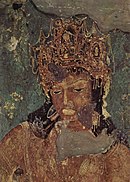Narendrasena
| Narendrasena | |
|---|---|
| Reign | c. 455 – 480 CE |
| Predecessor | Pravarasena II |
| Successor | Prithivishena II |
| Spouse | Ajjhitabhattarika |
| Dynasty | Vakataka |

| Vakataka dynasty c. 250 - 510 CE | ||||||||||||||||
|---|---|---|---|---|---|---|---|---|---|---|---|---|---|---|---|---|
|
||||||||||||||||
| Nandivardhana-Pravarapura Branch | ||||||||||||||||
|
||||||||||||||||
| Vatsagulma Branch | ||||||||||||||||
|
||||||||||||||||
Narendrasena (r. c. 455 – 480 CE[1]) was a ruler of the Nandivardhana-Pravarapura branch of the Vakataka dynasty. He succeeded his father Pravarasena II as Maharaja.
Early life
Narendrasena was possibly born to Ajnakabhattarika, who may have been the chief queen of Pravarasena II and is mentioned as the mother of "Narindaraja" (possibly referring to Narendrasena) in a charter from Pravarasena's 16th regnal year.[2] Sometime during his father's reign, Narendrasena was married to a princess named Ajjhitabhattarika who was described as the daughter of the "king of Kuntala". It is not known for certain who this "king of Kuntala" was, but he is often identified with the Kadamba king Kakusthavarman who is known to have married his daughters into several prominent royal families.[3][4][5]
Reign
The death of Pravarasena II may have been followed by a succession struggle, from which Narendrasena emerged victorious. Altekar supposes that Narendrasena successfully drove out the Nalas from his kingdom shortly after the death of Bhavadattavarman.
The inscriptions of
References
- ISBN 9788173051234.
- ISBN 9069801000.
- ^ a b D.C. Sircar (1997). Majumdar, R.C. (ed.). The Classical Age (Fifth ed.). Bharatiya Vidya Bhavan. p. 184.
- ISBN 9788120800434.
- ^ Sastri, K.A. Nilakanta (1961). A History of South India from Prehistoric Times to the Fall of Vijayanagar (Third ed.). Oxford University Press. p. 109.
- ISBN 9788131716779.
- ^ ISBN 9788120800434.
- ^ Bakker (1997), p. 29
- ^ "Vakataka dynasty | Indian history | Britannica". Britannica. Britannica. Retrieved 26 January 2021.


